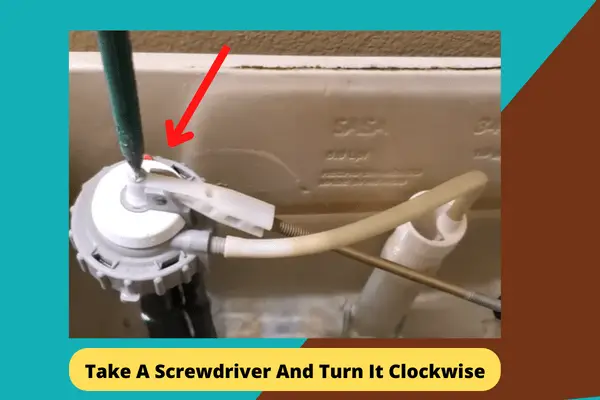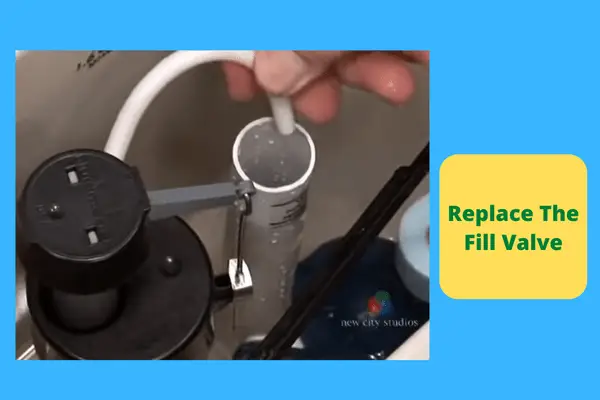If your toilet pulses when filling, be sure excessive water pressure in the toilet tank is the root cause of this issue. Plus, when the toilet fill valve wears out or at times due to a bad flapper causes pulsating in your toilet.

If all above aren’t able to stop the pulsing, it is sure the drain line of the toilet is blocked, or you are experiencing the “water hammer” effect, creating vibrations in your toilet.
When your toilet pulses while refilling, try readjusting the toilet float to lower the water level. Then, replace the faulty fill valve and flapper.
If they aren’t proven well, clean the drain line and fix the water hammer issue of your house. Get all details from the below article.
Table of Contents
Why Toilet Pulses When Filling [5 Easy Solutions]
Learn all the responsive factors for the pulsing toilet issue with quick solution procedures:
Note: You can also read how to fix the jacuzzi dual flush toilet keeps running.
1. Incorrect Water Level In The Toilet Tank
If your toilet is pulsing while filling, the first culprit would be the water level in the tank. Here, the problem may occur due to excessive water pressure from the tank.
That means it is sure that the water level is higher than usual for why the water is surging in the toilet tank. The best water level in the toilet tank is one to two inches below the toilet’s fill valve and/or overflow tube.
When the water level in the tank is too high, it causes the toilet to pulsate while refilling. So, only lowering the water level in the tank will solve the issue.
Note: Excessive water in the tank results from a misadjusted float if the toilet is the Ball-and-Arm Float configured. Or, if the toilet has a cylinder-shaped float, the wrong adjustment of the cylinder valves leads to the issue.
How To Lower The Water Level In The Toilet Tank
Adjust Ball-And-Arm Float:

- First, you have to turn off the water supply by rotating the water shut-off valve.
- Drain the remaining water in the toilet tank by flushing the toilet.
- Then, remove the toilet tank lid.
- Now, check the water level in the tank. If it is not 1–2 inches below the fill valve and overflow tube, you have to lower the water level.
- Access the plastic ball or float attached to a long arm at the top of the fill valve.
- To adjust the float height, locate a screw on top of the fill valve.
- You will need a screwdriver. Rotate the screw counterclockwise to lower the tank water level.
- Lastly, turn on the water shut-off valve and fill the tank.
- Then, flush the toilet to verify the water level.
Adjust A Cylinder Float:
If your toilet has a cylinder-type float, follow the below steps to lower the water level of the toilet tank:

- As usual, turn off the water supply before starting.
- Then flush the toilet and drain the water. Lift off the tank lid.
- From the inside toilet tank mechanism, locate an adjustment screw connected to the float and the fill valve.
- To decrease the water level, you need to turn the screw counterclockwise. Adjust the screw until the water level reaches 1–2 inches below the fill valve and overflow tube.
- Finally, turn on the water supply and flush the toilet several times to test the adjustment.
2. Worn-out Fill Valve
After ensuring a proper water level and still the toilet water pulsing while filling, it is sure that the fill valve of the toilet tank might be the reason now.
A toilet fill valve is the part of the toilet which is responsible for refilling the tank after being flushed. It allows the freshwater to enter the tank after a flush and shuts it off when the tank is full.
Most of the time, sediment can build up over the fill valve, which makes it less efficient. Also, this essential element may wear out, making it stiff and less flexible.
A worn-out or out-of-alignment fill valve is one of the most common reasons for creating a vibrating sound from the toilet.
The faulty valve starts bouncing up and down when it shuts off, leading to the toilet pulsing. Once you have confirmed the fill valve is the issue, you need to replace the faulty fill valve.
How To Replace The Fill Valve On A Toilet

- Turn off the water supply by rotating the shut-off valve clockwise.
- In the next step, drain the tank water by holding the flush button down.
- Now, remove the tank lid and set it aside.
- Then, locate the fill valve from the inside of the toilet tank.
- It is a plastic column in the configuration that includes the float and the on-off lever for filling. First, unclip the tube or hose of the fill valve connected to the overflow tube.
- Unscrew the nut that secures the fill valve that goes to the water supply line by turning it counterclockwise.
- Then, pull the supply line out of the valve and detach the fill valve.
- Now, take the new valve and install it in place. You have to clip the refill tube of the tank to the overflow tube.
- There is a lock nut on the threaded part of the valve located on the tank underside. Take a wrench or pliers and tighten the nut securely.
- Don’t forget to attach the supply line to the bottom of the new fill valve.
- Rotate the shut-off valve counterclockwise and turn on the water supply.
3. Bad Flapper
If your toilet starts pulsing, not just when you are flushing, the issue may actually lie with your toilet’s flapper. A toilet flapper is responsible for draining water from the tank into the bowl while flushing.
It is attached to the tank by a chain. While flushing, the handle moves the chain and lifts the flapper, which allows water to pass through the toilet bowl. When the flush concludes, the flapper drops back into place, and the tank begins to refill with water.
But this element can be the leading culprit in the case of toilet pulsating. In essence, when the flapper wears out or gets stuck, it might not make a full seal around the tank’s base, causing one of the more severe water leaks into the toilet bowl.
This leads to the slow leaking in the tank. Then, when the toilet starts refilling, the toilet pulses and may create a vibrating noise.
So, once you determine a bad flapper as the root cause for the toilet pulsing, your first and foremost step should be checking and replacing the faulty flapper.
How To Replace The Flapper On A Toilet [Quick Steps To Follow]
Learn the DIY methods on how you will change and install the new flapper on your toilet.

- First, turn off the water supply and flush the toilet.
- Lift off the toilet tank lid.
- Now, access the flapper. It is time to detach the old flapper.
- First, disconnect the flapper chain connected to the flush handle lever. Simply undo the clip from the top end of the chain, and the chain will drop.
- Now, pull the edges of the flapper free from the pegs extending from the sides of the flush valve tube.
- Take the new flapper. Slide the holes on either side of the flapper over the pegs on the valve.
- Then clip the lift chain and adjust the chain length in an accurate way.
- Turn on the water supply and test the new flapper by flushing the toilet.
4. Blockage In The Toilet Drain Line
After replacing the faulty fill valve and bad flapper, the blocked toilet is one of the big reasons if still, the toilet is pulsing. If the toilet drain line is clogged, the flush water partially fills the toilet and fails to clean the waste of the bowl. For this, the toilet may start pulsating while refilling.
The water surge could also be caused by blocked vent pipes. Mainly the blockages in the toilet vent pipe create negative air pressure in the toilet pipe, which leads to the toilet bubbling or pulsing. The vent pipe can be clogged from building up the calcium deposit inside them.
Anyway, after determining if the pulsing in the toilet is due to a clogged drain line or vent pipes, you need to unclog them.
How To Unblock Toilet Drain Pipe
Method 1: Plunge The Toilet
- A plunger cleans the toilet by creating an airtight seal with the drain. Take a plunger and insert it into the toilet bowl.
- Submerge the plunger fully in the water to push and pull water through the opening.
- Then, start plumbing the plunger into the hole.
- Push down and then pull up the plunger until you see the water begins to drain.
- Repeat the attempts about 15 to 20 times.
- Then flush the toilet 2-4 times to drain the loosened stubborn clogs.
- Repeat the entire process to ensure the clog is cleared away.
Method 2: Using A Plumbing Snake
- You can use a plumbing snake to clean the toilet clog.
- A plumbing snake is a flexible coil of wire which can easily go through the curves of a drain.
- Take a plumbing snake and insert it closure to the blockage.
- Now push the snake back and forth and break the obstruction by twisting it.
- Once finished, flush the toilet, and all the obstructed debris will be cleared from the drain line.
Method 3: Use A Chemical Drain Cleaner
Apart from all the above methods, you can use a chemical drain cleaner to dislodge the toilet clog. Several types of drain cleaners are available in the market that is used to remove the hard obstruction from the toilet drain line and sewer vents.
But before using a drain cleaner, you have to ensure that it is specifically made for toilets. Any other harsh chemicals damage your toilet pipes.
5. The “Water Hammer” Effect
Most of the time, the toilet makes pulsing noise due to the water hammer effect. The words might seem newer to you, but it is one of the most common reasons for the vibrations in the toilet.
A water hammer is mainly known as a hydraulic shock or hydraulic surge. It occurs in the piping system from a water pressure surge in your pipes or by a high-pressure shockwave.
Also, it may occur from a sudden valve shutdown from within the plumbing system, waterlogged air chambers, or unsecured pipe-mounting straps.
Due to a water hammer, the water in the pipes starts hitting up against a valve, and the valves will shut off too quickly. This causes a loud knock in the pipes during a flush, or the toilet starts pulsating while filling.
How To Fix Water Hammer In Toilet
Process 1: Create New Air Chambers
The method is effective for eliminating water hammers by creating a new air chamber in the pipes of your house.
- Turn off the water supply of your house from the mainline.
- Now open all the cold water faucets, and open with the highest faucet in your home.
- Then turn on the lowest faucet. Flush all toilets in your home.
- The water will start to drain from the open faucets. Continue this draining for about 20 to 30 minutes, and then close the faucets, starting with the lower one.
- After closing the faucet, the toilet will refill. Flush the toilet and check the water hammer.
Process 2: Install A Water Hammer Arrestor
If you’re experiencing the water hammer effect, you can fix this issue by installing a water hammer arrestor. These are small air-filled pipes that use a built-in piston to compress air to help reduce the shockwave created by quickly closing valves.
Anyway, contact a certified plumber to install arrestors for you.
FAQs:
Why do my pipes hammer when I flush the toilet?
A water hammer occurs when the valve opens while flushing and then suddenly shuts off. This creates pressure on the pipes, causing a loud banging noise from the pipes.
How do I remove air from toilet pipes?
To remove the air from the pipes, you need to open all the cold water faucets, starting with the highest one. Then open the lower faucets and let drain the water for some time. Close the faucets and flush the toilets.
Wrapping Thoughts
Well, that’s all we have!! Hopefully, now you have no more confusion on “why does my toilet pulsate when refilling”. Our above comprehensive guide is enough to solve this major toilet issue.
If your toilet pulses while filling, attempt all the suggested solving methods to eliminate this pulsating. Let us know if you face any more troubles while troubleshooting. We are always here for you.


About James
James founded HomeUpgradeLab & was sharing his experiences to fix issues related to bathroom and toilet fixtures & fittings. Read to know more about James Hill & how he started this blog.